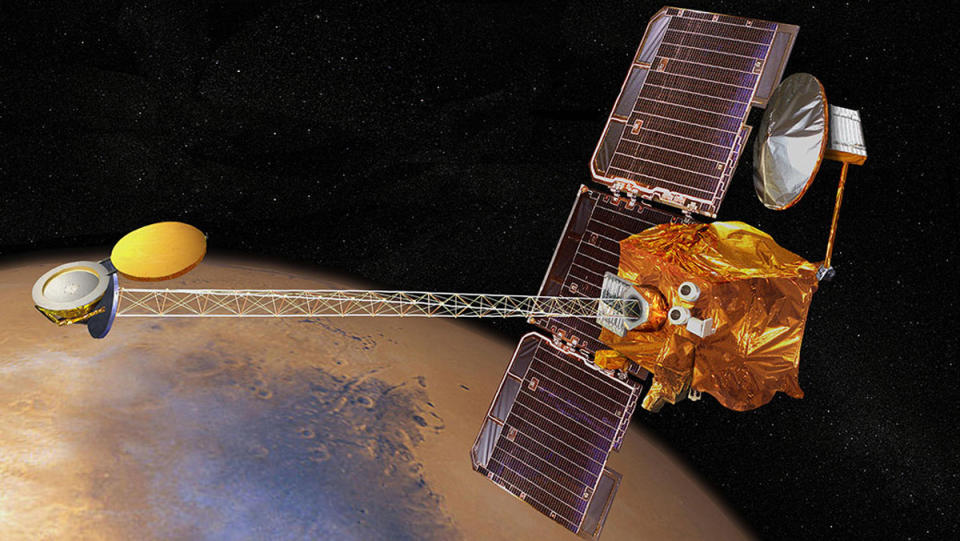NASA investigates veteran Mars orbiter to solve a missing fuel mystery

Engineers at NASA and Lockheed Martin Space have performed the difficult task of measuring the fuel supply of the oldest Mars orbiting spacecraft without the use of a fuel gauge, after calculations indicated the probe may be close to running on empty.
Estimates from 2021 and 2022 indicated the Mars Odyssey orbiter has exhausted its propellant much faster than expected, prompting the investigation of the craft's "missing fuel." Eventually, the scientists concluded that the missing fuel was never missing at all! That means Odyssey should have enough propellant to keep going until the end of 2025.
The Mars Odyssey orbiter has been in space for 22 years. During this time, the mission has completed over 94,000 orbits of Mars and delivered a wealth of impressive discoveries such as the detection of water ice under the planet's surface that could be used by future astronauts.
Related: The big reveal: What's ahead in returning samples from Mars?
During its mission, Odyssey has traveled the equivalent of 1.37 billion miles (2.21 billion kilometers) around Mars, which has required careful fuel management. The problem is that the spacecraft, launched in 2001, isn't fitted with a fuel gauge.
That means NASA operators have to rely on mathematics and ingenious tests to calculate how much of the 500 pounds (225.3 kilograms) of hydrazine propellant the craft lifted off from Earth with is left.
The remaining fuel supplies are measured by applying heat to Odyssey's two propellant tanks to see how quickly they reach a set temperature, which indicates how full of fuel they are. Just like an empty teapot which heats up faster than a full one, an empty fuel tank should hit a target temperature more rapidly than a full one, NASA said in a statement.
In 2021, the test indicated that Odyssey had just 11 pounds (5 kg) of propellant left, which is less than mathematical modeling of the probe's fuel consumption predicted. In January 2022, the NASA team used the method again, and again came up with a lower than expected amount of remaining fuel: just 6 pounds (2.8 kg) of hydrazine. If the results are correct, Odyssey would be running on empty in less than a year.
The engineers didn't know how to explain the discrepancy between the test results and the expectations and set out to conduct a deeper investigation, which revealed hitherto unknown details about how the craft's complex fuel system has aged while in flight.
So where did Odyssey's "missing fuel" go?
Following the calculations that indicated the Mars Odyssey Orbiter may be running low on fuel, NASA Jet Propulsion Laboratory (JPL) scientists drafted in Lockheed Martin Space engineers, who not only built Odyssey, but also maintain its mission operations and provide engineering support for the craft.
"First, we had to verify the spacecraft was OK," Odyssey's project manager at JPL, Joseph Hunt, said in the statement. "After ruling out the possibility of a leak or that we were burning more fuel than estimated, we started looking at our measuring process."
The combined JPL/Lockheed Martin Space team decided that they needed "fresh eyes" to assess the Odyssey issue. These fresh eyes came in the form of spacecraft propellant estimation consultant, Boris Yendler.
Yendler connected the missing fuel to the fact that, like all spacecraft, Odyssey uses some fuel to keep its systems at optimal operating temperatures and protect them from the cold of space. The consultant wondered if some source on Odyssey was adding heat to its fuel. This would have the effect of causing temperatures to rise faster during the fuel tank heating test, thus giving inaccurate fuel measurements.
The painstaking investigation led to the discovery that heaters along an Odyssey fuel line were warming connected propellant tanks, making them appear emptier than they actually are. Accounting for this in their method of measurement and factoring in more complex fluid dynamics, the team was able to determine that Odyssey has about 9 pounds (4 kg) of hydrazine left.
Mars Odyssey doesn't actually burn through much fuel each day, as solar panels on the craft supply the energy needed to power its systems. Additionally, the probe uses reaction wheels to stay pointed toward Mars during science investigations. These wheels spin inside the spacecraft's body, generating torque that allows Odyssey to maintain its attitude without propellant.
Related stories:
— New evidence for liquid water on Mars suggests the planet is geothermally active
— Mars crater complex shows layers of ice in stunning spacecraft photos
— Melting ice cores on frozen worlds could speed up the search for alien life
Where the hydrazine actually comes in is when Odyssey completes a full orbit and needs to offload increasing momentum in its reaction wheels. The spacecraft does this by releasing tiny precisely measured bursts of propellant via its thrusters.
Thanks to such limited use Odyssey has enough fuel left to last a few more years at least. The team, however, acknowledges that the remaining fuel quantity they calculated may change as they refine their calculations and improve measurement accuracy. Nevertheless, the team is certain that they now understand the craft better than they did previously.
"It's a little like our process for scientific discovery," Odyssey's mission manager at NASA JPL, Jared Call, said in the statement. "You explore an engineering system not knowing what you'll find. And the longer you look, the more you find what you didn't expect."
Follow us on Twitter @Spacedotcom or on Facebook.

 Yahoo Autos
Yahoo Autos 